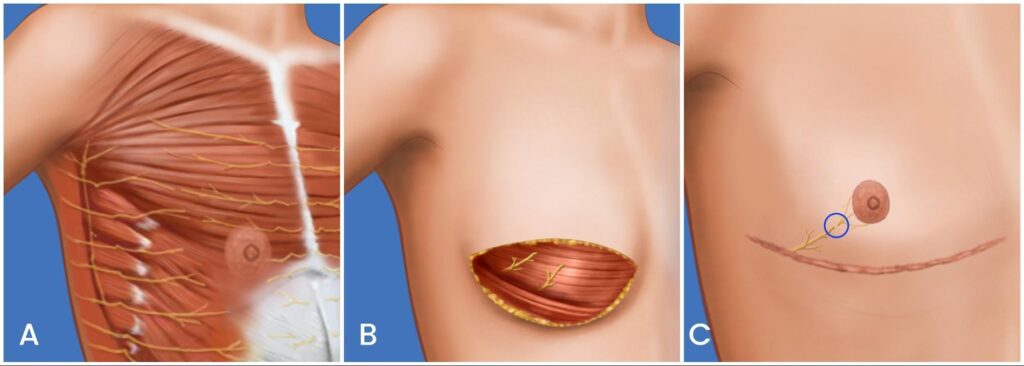The Why:
There are several approaches to removal of breast tissue in trans-gender patients considering top surgery. One of the most common and effective techniques is the double incision (DI) top surgery with free nipple grafting (FNG) because it allows for significant felxibility to optimally reshape the chest contours to create an ideal masculine appearance. Furthermore, the FNG technique gives patients complete control over resizing the dimensions of the nipple and areola and control over where the areola and nipple are placed on the chest. Unfortunately, in the majority of cases, the cost of having a double incision (DI) top surgery with free nipple grafting (FNG) is the loss of meaningful sensation to the nipple-areola complex.
Here at Peled Surgery, we are fortunate to have established a collaboration with the Gender Confirmation Center (GCC) and Dr. Scott Mosser (he/him) to offer a sensation preservation technique so that patients can potentially have the best of both worlds. We are so enthusiastic about this work, which we feel will help many patients in the community.
The reasons for wanting sensation-preserving top surgery are as diverse as the patients who walk through our doors. For some:
- Having notable nipple sensibility is important for sexual pleasure and satisfaction.
- Loss of sensation can result in a feeling of disconnection from one’s own body.
- Having a meaningful amount of nipple and chest wall feeling can be significant in terms of experiencing everyday sensations like the chest wall moving while moving your arms during exercise or when hugging loved ones.
The How:
As noted above, the double incision technique allows surgeons to remove medium to large amounts of chest tissue to maximize the flatness and tightness of the chest. As with virtually all mastectomies, however, this procedure necessarily results in cutting many of the nerves that provide sensation to the central chest wall area including the nipple and areola. The sensation preservation technique developed by Dr Peled achieves its outcomes in two ways. First, before the breast tissue is completely removed, the relevant nerves are meticulously dissected free from the chest wall as close to the nipple and areolar as possible.
These nerves are then connected to the underside of the tissue, close to where the nipple/areola graft will be placed. These steps are illustrated above in panels A, B and C. The second approach is required when the dissected nerve ends do not reach the underside of the new nipple location. In that case, a second nerve is identified and harvested as a nerve graft, then connected to both the intact nerve and the underside of the nipple/areola complex. The effectiveness of this approach has been proven in several clinical studies (see references below).
The Results:
Dr. Peled has several published, peer-reviewed papers demonstrating good success with these neurotization techniques. [1-3] Initially, he started performing nipple neurotization alongside his wife in cis-women undergoing mastectomies for breast cancer prevention or treatment. Following removal of the breast tissue, an implant or flap is placed to recreate the breast mound and shape. The nerves are then reconnected to the nipple/areolar complex in the same way as described above to allow for preservation of sensation post-op. In a study of cis-women who underwent this procedure, over 80% of patients had good-to-excellent sensibility scores at all areas of the breast and nipple/areola tested as early as 6 months post-op, with further improvements 12 months after surgery. [1]
This degree of success is likely in top surgery patients as well since the chest wall is being brought down to the nerves without an interposing flap or implant, potentially allowing for improved neural connections. It is also theoretically possible that some top surgery patients might experience better nipple sensation post-op than they had pre-op because a larger nerve bundle coming from the chest is applied directly in some cases to a smaller, resized nipple graft. A small study of patients who underwent neurotization following top surgery maintained similar levels of sensation in their nipples post-op. [4] Other studies have noted very similar results without major operative complications. [5-7]
Am I A Candidate And If So, What Next?
All top surgery patients can be candidates for neurotization. Results can vary depending on age, prior surgery on the breast or chest wall, other medical problems, BMI and other factors. These factors will be discussed in your consultation. The healing time following this procedure is also different for each patient. Some neurotization patients may begin to recover sensation as early as 3 months after surgery and most are expected to have at least some sensation back by 6 months following their operation. Final results can take up to one year to be realized. Essentially, patients often experience sensation gradually improving within that first year after top surgery with neurotization. As the nerves heal, it may be normal to experience temporary hypersensitivity or discomfort (i.e., sharp or itching sensations underneath the skin) but these sensations are often mild and gradually disappear.
Neurotization is less commonly performed as a revision procedure for former top surgery patients due to a lower probability of success. In Dr. Peled’s experience, patients who come in for nerve grafting procedures after they have already had their breast tissue removed in the past, have about a 50% chance of success. That is, only about half of delayed neurotization patients successfully recover reasonable sensation in their nipples/areolas. The more time that passes after the initial operation, the more likely it is that the nerves on the chest wall may have atrophied and thus will require more dissection or different types of grafts. Beyond the difficulty of finding a usable nerve stump from which to graft and needing a long nerve graft, it may also be more difficult for the brain to re-learn the perception of stimuli from the NAC after having had little or no sensation for long periods of time. These factors likely all contribute to the lower chance of success for delayed neurotization.
While we stongly believe that neurotization is a medically necessary procedure, we cannot guarantee that it will be covered by insurance because it is a relatively new procedure within the world of gender-affirming surgery. For cash pay patients not using insurance, neurotization can cost between $5,000-$9,000. Pricing is based on the technique used to accomplish sensation preservation. A more precise, overall cost can be determined once you have had your surgical consultation.
In summary, having optimal sensation to any part of the body is important to many people for many reasons. If you are interested in undergoing this procedure, you can book a virtual or in-person consultation with Dr Peled today. We invite you to learn more about this procedure with us and we look forward to helping you on your journey.
Sources
- Peled, Anne Warren MD, von Eyben, Rie PhD, Peled, Ziv M. MD. Sensory Outcomes after Neurotization in Nipple-sparing Mastectomy and Implant-based Breast Reconstruction. Plastic & Reconstructive Surgery-Global Open 2023;11(12:) e5437
- Peled, Anne Warren MD, Peled, Ziv M. MD, Sensate Immediate Breast Reconstruction, Peled, Gland Surgery 2024;3(4) 552-560.
- Peled, Anne Warren MD, Peled, Ziv M. MD. Nerve Preservation and Allografting for Sensory Innervation Following Immediate Implant Breast Reconstruction. Plastic & Reconstructive Surgery-Global Open 2019; 7(7):p e2332,
- Rochlin, Danielle H. MD; Brazio, Phil MD; Wapnir, Irene MD; Nguyen, Dung MD, PharmD. Immediate Targeted Nipple–Areolar Complex Reinnervation: Improving Outcomes in Gender-affirming Mastectomy. Plastic and Reconstructive Surgery – Global Open 8(3):p e2719, March 2020.
- Hu, Allison C. MD; Makarewicz, Nathan S. BA; Sharma, Ayushi MD; Nguyen, Dung H. MD, PharmD. Impact of Nipple Areolar Complex Reinnervation on Sensory Outcomes Following Gender-Affirming Mastectomy. Plastic & Reconstructive Surgery-Global Open 12(1S1):p 63, January 2024.
- Remy, Katya MD; Packowski, Kathryn; Kozanno, Liana; Winograd, Jonathan MD; Carruthers, Katherine MD; Tomczyk, Eleanor MD; Austen, William Gerald Jr. MD; Valerio, Ian MD, MS, MBA, FACS; Gfrerer, Lisa MD, PhD. Intraoperative Anatomy and Postoperative Sensation of Targeted Nipple Areola Complex Reinnervation in Gender-affirming Double Incision Mastectomy with Free Nipple Grafting. Plastic & Reconstructive Surgery-Global Open 11(10S):p 75, October 2023.
- Naides, Alexandra BFA1; Cece, John MD1; Doshi, Kathryn PA-C2; Keith, Jonathan D. MD, FACS, MD, FACS3,2. QS14. Neurotized Chest Masculinization for Improving Nipple Sensation: Survey Results. Plastic and Reconstructive Surgery – Global Open 10(6S):p 97, June 2022.



